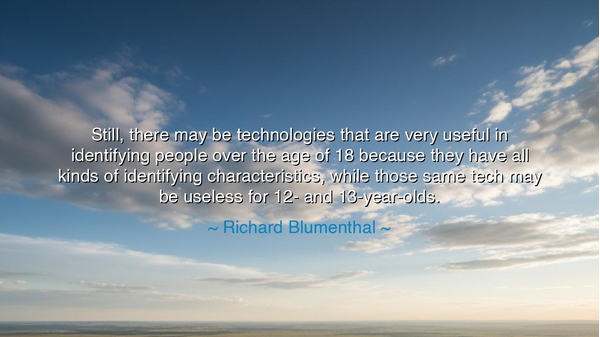
Still, there may be technologies that are very useful in
Still, there may be technologies that are very useful in identifying people over the age of 18 because they have all kinds of identifying characteristics, while those same tech may be useless for 12- and 13-year-olds.






"Still, there may be technologies that are very useful in identifying people over the age of 18 because they have all kinds of identifying characteristics, while those same tech may be useless for 12- and 13-year-olds." These words spoken by Richard Blumenthal speak to the complexities of technology and its relationship to human identity. In the age of rapid technological advancement, we are surrounded by devices and algorithms designed to identify, track, and classify us based on various characteristics. Blumenthal's reflection highlights a profound challenge: that while technologies may be effective in distinguishing adults from children, they are often less reliable when it comes to accurately identifying younger individuals. This tension between the capabilities of modern technology and the fluidity of human growth underscores a central issue in the ethical and practical use of technology in our lives.
In the ancient world, there were similar debates regarding the use of tools and methods to understand the world. Take, for instance, the Greek philosophers and their inquiries into the nature of human knowledge and identity. Plato, in his works, pondered deeply on the essence of being, and how one could accurately determine a person's true nature. In his Republic, Plato argued that understanding people requires more than just external signs—it requires a deep insight into their character and soul. He understood that human beings cannot be reduced to simple categories or appearances. In a similar way, Blumenthal is pointing out that while technology can help us identify certain physical characteristics or age markers, it may not fully capture the complexity of an individual’s identity, especially when dealing with children who are in the process of forming their unique selves.
This concern over the limitations of technology can also be seen in the rise of biometrics—a technology designed to identify people based on their physical traits, such as fingerprints or facial recognition. In ancient times, there was a belief that the soul could not be captured or defined by external means, a belief found in the mystical traditions of the Egyptians and Romans. The Egyptians, for example, understood that the essence of a person was found in their ka (spirit) and ba (soul), not simply in their appearance or physical features. They believed that the true nature of a person could not be reduced to a body, and this ancient wisdom resonates with the challenges Blumenthal discusses—technology can measure certain aspects of identity, but it struggles to capture the full complexity of the human being.
The ethical implications of using such technologies on children, particularly those in the adolescent stage, are deeply significant. Children and teenagers, like the ancient Greek heroes, are in a constant state of change and growth. Their physical and mental development is ongoing, making it difficult for any technology to accurately capture their identity. Take, for example, the story of Alexander the Great, who, though he was a young man when he rose to power, was a vastly different person at the time of his death than when he first set out to conquer the world. His transformation was not only physical, but also psychological and emotional. Similarly, the adolescents of today are undergoing transformations that cannot easily be categorized by a single set of characteristics. The true essence of a person at the age of 12 or 13 cannot be encapsulated in a snapshot provided by a machine.
Blumenthal’s cautionary words also speak to the increasing power of technology in our lives, and the responsibility we have to ensure its ethical use. Just as the ancients wrestled with how to use knowledge and tools for the benefit of society, so must we grapple with how to wield modern technology. Plato warned of the dangers of relying too heavily on external tools without understanding their implications. Today, we are faced with the challenge of navigating the fine line between the convenience and efficiency that technology offers, and the potential harm it can cause when used improperly, particularly when it comes to children. Blumenthal’s words remind us that technology, no matter how sophisticated, cannot replace the need for wisdom and human judgment.
The lesson here is one of awareness and caution. We must recognize the limitations of the tools we create, especially when it comes to the delicate task of understanding and categorizing human beings. Technology should be used not to replace the complexity of identity, but to enhance our ability to understand each other. Just as Plato urged us to look beyond the surface to understand the true essence of a person, so too must we be mindful of the limitations of technology and the need for a more holistic approach to identifying and understanding individuals. In practical terms, this means we must push for ethics and accountability in the use of technology, ensuring that we do not oversimplify the nuances of human development, particularly when dealing with the identities of young people.
Therefore, let us proceed with both curiosity and humility when it comes to the use of technology. As we continue to develop and refine these tools, we must also cultivate a deep understanding of the human condition. Technology can aid us, but it must never define us. In the spirit of the ancients, we must always seek a balance between innovation and wisdom, ensuring that we use the tools we create to serve humanity, not reduce it to a mere set of data points.






AAdministratorAdministrator
Welcome, honored guests. Please leave a comment, we will respond soon